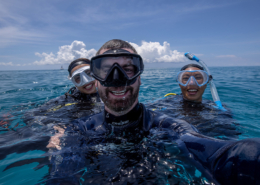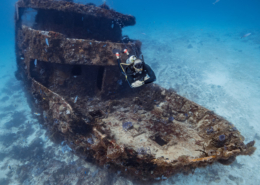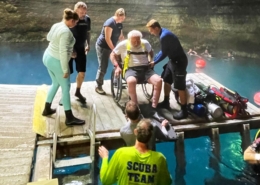What is Freediving?
By: Chris Bustad
PFI Instructor Trainer
Some say freediving (one word activity of freediving, rather than the two word no-cost free diving) is diving without equipment. However, that isn’t entirely the case. Most people that are freediving still wear a mask, fins, snorkel, weight and belt, wetsuit, and even some other accessories. Really freediving is diving free from a source of breathing gas, whether SCUBA or surface supplied.
Then there is also the question of what is the difference between snorkeling and freediving? Generally, the difference between them is defined by the amount of time the water goer is holding their breath while dipping below the surface, and/or how deep they go. PFI makes the distinction at the 30 seconds mark, or the 5-meter/16-feet mark, longer or deeper than that, and you are venturing into freediving territory.
There are many different aspects, disciplines, or uses for freediving. We will be touching on just a few of the big ones below.
SUSTAINABLE HARVESTING
A very large number of people that get into freediving are using it to harvest fish and shellfish. This is the oldest form of freediving in the world. There is evidence of humans freediving for sustenance at least 10,000 years ago. The beauty of using freediving for harvesting food is that being on breath hold helps to equals the playing field, and there is no bi-catch when done responsibly. The freediver gets to pick the fish or shellfish to be harvested, rather than blindly getting what they get.
 UNDERWATER EXPLORATION
UNDERWATER EXPLORATION
The largest growing group of freedivers are those that wish to see what is going on underwater locally and around the world. Being able to throw on a little gear and see what lies beneath the waves is both thrilling and meditative at the same time. The wildlife in the water tends to be less skittish when we don’t have a SCUBA unit attached to our backs. Whether seeing what is living on an exotic coral reef, watching large animals in the open ocean, or the fish that live under the dock at the nearby lake or river, freediving will get you closer to the action.
 MOVIE ROLES
MOVIE ROLES
Perhaps you have watched Avatar: The Way of Water, Mission Impossible – Ghost Protocol, or Suicide Squad, what do those have in common? They were all had scenes where dozens of cast, crew, stuntmen, and safeties were trained by PFI and used freediving for underwater shots for more realism rather than shooting on dry land and acting like they were under water.
 MERFOLK
MERFOLK
Another rapidly growing side of freediving is merfolk. Freedivers will learn how to hold their breath longer so that they can put on a tail and fin and enjoy life in the water as merfolk. Whether entertaining people at a party, enjoying being a mermaid, TV and Movies, as a model, or any other way, merfolk bring enjoyment to thousands of people every day.
BREATH HOLD SURVIVAL
The Breath Hold Survival program was developed for big wave surfers. However, it has many applications for situations that require the ability to hold your breath while in a high stress situation rather than as relaxed as possible with freediving. Surfers, kayakers, military special forces, police and fire rescue, lifeguards, and many other groups utilize these courses to help keep themselves safer.
COMPETITIVE FREEDIVING
When most people think of freediving they are thinking of the competitive side of the sport. For competitive freedivers, they are seeking the most efficient ways to go deeper, farther, or hold their breath longer for a single target dive. There are multiple disciplines that freedivers choose from, often specializing in one specific discipline. There are different disciplines that are broken into two groups: depth and pool.
-
Depth Disciplines:
- Constant Weight Mono-fin – diving to an announce depth using a single fin that both feet are attached to. The freediver will descend and ascend with the same amount of weight.
- Constant Weight Bi-fin – same as above, but the freediver uses two long-blade fins.
- Constant Weight No-fin – this time the freediver does not have any fin.
- Free Immersion – the freediver has no fins and uses the line to pull themselves to the announced depth.
- Variable Ballast – the freediver will ride a sled to depth, and return to the surface under their own power, either kicking or free immersion.
- No Limits – the freediver will ride a sled to depth, then activate a lift bag and ride up using the buoyancy of the lift bag. No limits freediving is no longer practiced in competitions due to the risks involved.
-
Pool Disciplines:
- Static Apnea – this is where the freediver will lay motionless on the surface of the water and hold their breath for maximum amount of time.
- Dynamic Mono-fin – the freediver travels for distance back and forth in the pool underwater to achieve maximum distance using a mono-fin.
- Dynamic Bi-Fin – same as above with bi-fins
- Dynamic No-Fin – for distance not using any fins.
No matter what draws you into freediving, realize that each has its own techniques and risks. Finding an appropriate PFI Freediving Instructor to teach those techniques and how to mitigate the risks will go miles to increase your freediving experience.



 UNDERWATER EXPLORATION
UNDERWATER EXPLORATION MERFOLK
MERFOLK

 William Drumm/ International Training
William Drumm/ International Training William Drumm/International Training
William Drumm/International Training





Ostavite odgovor
Želite li da se priključite diskusiji?Slobodno popunite!